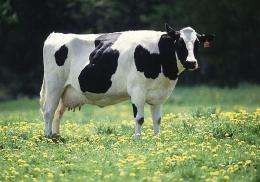Constructing antimicrobials that destroy bacteria

(Phys.org) -- U.S. Department of Agriculture (USDA) scientists have developed a new method to create antimicrobials that kill disease-causing pathogens. These antimicrobials can be used as an alternative to antibiotics.
Growing concerns about antibiotic resistance to certain strains of bacteria and increasing restrictions on the use of antibiotics in animals has accelerated the need to find alternatives. Scientists with the Agricultural Research Service (ARS), the chief intramural scientific agency of USDA, are working to provide new strategies for enhancing production and improving overall animal health. This research supports the USDA priority of promoting international food security.
The patented technology for designing pathogen-targeted antimicrobials is the work of molecular biologist David Donovan at the ARS Henry A. Wallace Beltsville Agricultural Research Center (BARC) in Beltsville, Md. Donovan works in the center's Animal Biosciences and Biotechnology Laboratory.
Viruses that infect bacteria, called bacteriophages (phages), produce enzymes that can be used to kill pathogens. These novel enzymes have been shown to be effective in killing pathogens like streptococci and methicillin-resistant Staphylococcus aureus, also known as MRSA.
Collaborating with industry, university and federal scientists, Donovan demonstrated that these particular enzymes have molecular domains that can be isolated and will act independently of their protein surroundings. They kill bacteria by eating or chewing up the walls of cells.
The enzymes can be manipulated to create an antimicrobial that targets and kills only specific pathogens. This greatly reduces the probability that non-targeted bacteria will develop resistance.
Read more about this research in the May/June 2012 issue of Agricultural Research magazine.
Provided by Agricultural Research Service

















